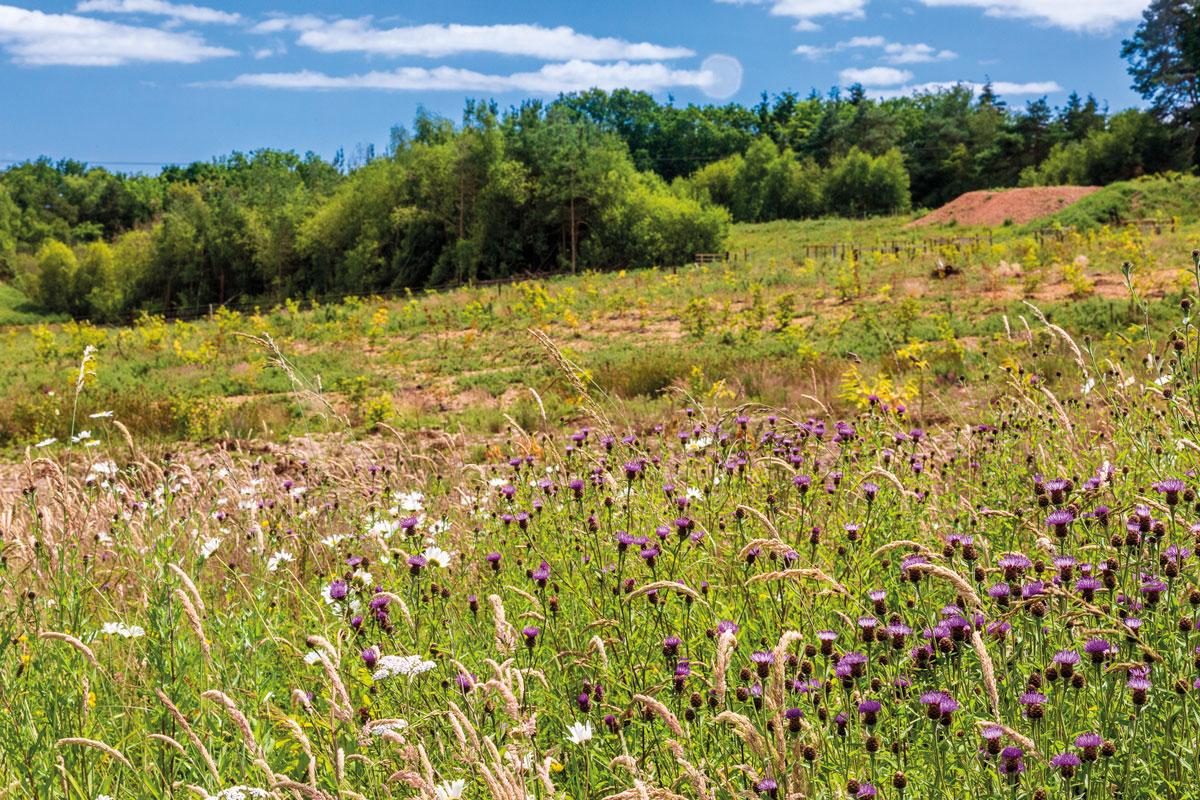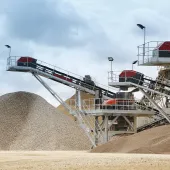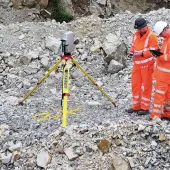Site Restoration and After-use

First published in the May 2022 issue of Quarry Management
Achievements, opportunities, and challenges
By David Payne, senior planning advisor, Mineral Products Association
In England alone there are over 2,000 active quarries, covering 64,000ha (0.1% of the country’s land area). All this land is under temporary stewardship of mineral operators and all of it will be restored after quarrying.
Restoration, and aftercare, is of course a requirement and component of planning permission for mineral extraction. Restoration schemes are a result of dialogue and agreement between the operators, planning authorities, other regulators, and the community, more often than not delivering a range of after-uses and benefit. Restoration is a sophisticated exercise involving many disciplines including geologists, landscape architects and designers, ecologists, and planners.
That was not always the case. Until the second half of the 20th century many mineral extraction sites were effectively left for nature to take over once production ended. Quarry restoration first became formalized to restore high-quality farmland, but priorities have changed over the years. Of course, although biodiversity features prominently in most schemes, restoration is also about making appropriate use of land with some sites being restored back to agricultural use, or for recreation, and in some cases for new development – including housing, commercial, and leisure uses.
Variety
The design of each scheme will reflect local circumstances, the type of mineral and nature of the working. For example, rock quarries producing minerals such as granite and limestone tend to operate for a much longer period, with deep excavations, than shallower sand and gravel sites. Industrial minerals may be worked on an ad hoc ‘campaign’ basis with different parts of a site being revisited over time depending on the type of material and market demands.
The right conditions – soils, hydrology, topography – and the availability of machinery, experience, knowledge, and skills means that the industry can deliver imaginative and innovative restoration schemes to restore and enhance landscapes and create new spaces for people and wildlife. Biodiversity-led schemes, in particular, can deliver multiple benefits – ‘ecosystem services’ such as recreation, flood alleviation, water quality, and carbon sequestration.
Achievements
By 2021 Mineral Products Association (MPA) members had created over 83km2 of UK priority habitat supporting nature recovery with a further 110km2 pledged in approved restoration plans, areas the size of Nottingham and Liverpool respectively (fig.1.). And today more than 80 restored quarries make up the MPA’s ‘National Nature Park’[1] of sites restored to nature conservation use with varying degrees of safe public access.
No other industry comes close to achieving this. The MPA was the first trade association to publish a biodiversity strategy[2] which it then reviewed and updated in 2020. The sector remains far ahead of the vast majority of industry by having a long-lasting strategy that can evidence meaningful improvements.
The quality and diversity of quarry restoration is celebrated by the MPA in its biennial Quarries and Nature (Restoration and Biodiversity) Awards[3], which showcase, reward, and share best practice among industry and a wide range of stakeholders. And the landscape-scale award in partnership with Natural England recognizes schemes that, due to their size, are clearly contributing to the principles ‘bigger, better and more joined up’ set out by Professor Sir John Lawton in the review of England’s wildlife sites ‘Making Space for Nature’[4].
The MPA has recently celebrated the 50th anniversary of the awards and brought together some of the best examples in a booklet[5] (fig. 2) and film[6].
Policy
In response to dramatic and continuing declines in habitats and species[7], in the UK and globally, government policy is moving quickly and decisively beyond simply protecting what remains, and encouraging nature recovery.
The 25 Year Environment Plan for England[8] includes the proposal to establish a National Nature Recovery Network to protect and restore wildlife, including a target to provide 500,000ha of additional habitat – including through delivering landscape-scale enhancements, reflecting Professor Lawton’s recommendations – and opportunities to re-introduce species.
The Environment Act 2021 will mandate (in 2023, following the introduction of secondary legislation and guidance) all new developments, including mineral extraction, to deliver an overall increase – a ‘net gain’ – in biodiversity post-development, with Defra and Natural England developing a calculation Metric[9] to be used to demonstrate this. The Act also provides for halting decline in species by 2030 and requires the preparation of Local Nature Recovery Strategies (LNRSs) covering the whole of England (probably based on counties) which include identification of priorities for nature recovery and mapping of existing sites of biodiversity importance, and areas with potential for enhancement. Further consultation on the preparation of LNRSs and environmental targets is currently under way, with a Nature Recovery Green Paper issued recently[10].
The minerals industry is uniquely placed to be able to contribute to nature recovery through site management, restoration, and after-use, especially as much of this can be delivered on-site during and after development. Frustratingly, there is barely any recognition of this potential in the various policy documents or generally among civil servants and politicians.
Challenges and opportunities
Perhaps the biggest challenge and opportunity will be delivery of biodiversity net gain (BNG). The approach and the Metric were introduced primarily to address the loss of biodiversity and failure of other types of development (particularly new housing development) to deliver enhancement, rather than to address any shortcomings of mineral extraction. As such, it includes assumptions and values that do not reflect specific experience and evidence from minerals development and restoration and is not designed to be easily usable for developments that may be operational for many years with phased working and restoration and associated long-term changes in biodiversity value. A number of these issues are discussed in previous editions of this publication[11].
BNG well in excess of the minimum 10% can be delivered on site through management and restoration if the Metric is applied in ways that properly reflect the progressive changes over the life of a mineral operation. Defra has recently undertaken further consultation on biodiversity net gain regulations and implementation[12]. The MPA pressed again for the Metric and associated tool to be modified to reflect the unique characteristics of mineral extraction, ideally through a separate worksheet with values reflecting real-world experience and evidence. A series of ‘principles’ was also suggested to assist implementation and hopefully inform the guidance that Defra intends to produce including:
- Early engagement to agree the target percentage of BNG for a site;
- Upfront offsetting for initial losses in biodiversity should not be required where BNG in excess of the minimum 10% will be delivered over the lifetime of the development;
- Assessment using the Metric may be undertaken before and after the development, or at periods throughout the development to provide illustrative ‘snapshots’ of progress;
- BNG should not be required at every phase or illustrative ‘snapshot’;
- ‘Interim’ and ‘temporary’ habitats created before and during extraction should be accounted for;
- Outputs from the Metric should be considered alongside professional judgement (ecologists and planners);
- Flexibility to reflect operational changes that may occur during the life of a quarry and revisions to a restoration scheme;
- For physical extensions to existing sites, only apply BNG to the area of new development where there will be changes to habitat cover;
- BNG should not be required for section 73 applications for changes to restoration schemes or extensions of time.
Concerns have been expressed that increasingly extraction is undertaken under leasehold, with the restoration and after-use being dependant on the requirements of the landowner. BNG requires maintenance of the created habitats for at least 30 years, which may prove unattractive to some, resulting in difficulties in progressing some sites (and a potential risk to future reserves) unless off-site BNG can be secured. BNG may also compete with other desirable after-uses, including agriculture and development. The availability of fill required for engineering including habitat creation, and potential definition as disposal rather than recovery, adds further complexity.
On the positive side, the industry is undoubtedly better placed than most to embrace BNG. Evidence indicates that while achieving well in excess of the 10% biodiversity net gain is achievable on site, especially at sand and gravel sites, this may be more difficult for rock quarries or where the existing land is highly valued in the Metric. A number of planning authorities are also considering requiring more than 10%, although the justification for another arbitrary target is not clear. Where biodiversity gain ‘surplus’ additional to the agreed target percentage can be delivered, this should be able to be ‘traded’ as off-site biodiversity units for other developments, including mineral extraction unable to deliver on site. Mineral extraction would also be an enabling mechanism to enhance biodiversity in Local Nature Recovery Strategies and should be identified as appropriate in the ‘opportunity’ areas and reflected in minerals local plans.
Conclusion
We have come a long way. Restoration of quarries is widely recognized as a success story and major opportunity to improve the environment. Whilst there are challenges ahead, the minerals industry is well, and possibly uniquely, placed to contribute to the successful delivery of environmental net gain alongside the provision of the essential minerals our nation requires.
References
- https://mineralproducts.org/Campaigns/Quarries-and-Nature/MPAs-National-Nature-Park.aspx
- MPA (2020) Biodiversity Strategy Building on our legacy – realising our potential
https://mineralproducts.org/MPA/media/root/Publications/2020/MPA_Biodiversity_Strategy_2020.pdf - See for example the films produced as part of the 2019 Quarries & Nature awards
https://www.youtube.com/playlist?list=PLXu4cRX3643ed88CZJFb6vmKAOAEgVeI6 - Making Space for Nature – A review of England’s Wildlife Sites and Ecological Network
https://webarchive.nationalarchives.gov.uk/ukgwa/20130402170324mp_/http://archive.defra.gov.uk/environment/biodiversity/documents/ 201009space-for-nature.pdf - MPA (2021) Quarries & Nature – a 50 year success story
https://mineralproducts.org/MPA/media/root/Publications/2021/Quarries_and_Nature_Brochure_2021.pdf - https://www.youtube.com/watch?v=J3j54TrOvVs
- See for example House of Commons Environmental Audit Committee (2021) Biodiversity in the UK: Bloom or bust? Report HC 136.
https://committees.parliament.uk/publications/6498/documents/70656/default/ - HM Government (2018) A green Future: Our 25 Year Plan to Improve the Environment
https://www.gov.uk/government/publications/25-year-environment-plan - http://publications.naturalengland.org.uk/publication/6049804846366720
- Defra (2022) Nature recovery green paper: protected sites and species
https://consult.defra.gov.uk/nature-recovery-green-paper/nature-recovery-green-paper/ - For further discussion, see Humphries R.N. The Biodiversity Metric 3.0 and Minerals – opportunities, constraints and possible consequences for industry. Quarry Management, September 2021
- https://consult.defra.gov.uk/defra-net-gain-consultation-team/consultation-on-biodiversity-net-gain-regulations/
- Subscribe to Quarry Management, the monthly journal for the mineral products industry, to read articles before they appear on Agg-Net.com








